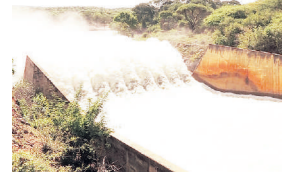
Masinga dam, Kenya’s largest hydroelectric reservoir, has defied mounting climate pressures to maintain a stable water level, offering relief to Kenyans from unpredictable rainfall patterns.
KenGen managing director and CEO Peter Njenga said the high level of water is a welcome development at a time when climate change continues to affect hydroelectric power production, putting energy planners under growing pressure to diversify the country’s power sources.
“This kind of stability at Masinga and the other hydropower stations is welcome, but it is no longer something we can take for granted,” Njenga said.“We are operating in a new reality, and that’s why we are investing heavily in geothermal to shield Kenyans from the vagaries of rain-fed power production.”
Data from the NSE-listed Kenya Electricity Generating Company shows Masinga holding at 1,056.97 meters above sea level, surpassing the maximum level of 1,056.50.
Njenga said this is a big boost to Kenya’s electricity grid, as Masinga dam anchors the Seven Forks cascade, which is a system of five interlinked hydro stations that collectively power a significant share of the nation’s economy. Kamburu, Gitaru, Kindaruma, Kiambere, Turkwel, Sondu, and Sang’oro power stations continue to hold strong, operating at maximum water levels.
Hydroelectricity is Kenya’s cheapest and most established source of power, but it is also the most vulnerable due to shifting rainfall patterns. With droughts in recent years cutting deep into production, the country’s reliance on water-fed dams is being re-evaluated.
Geothermal energy, tapped from deep beneath Kenya’s volcanically active Rift Valley, today accounts for more than 42 per cent of the country’s daily power consumption. Unlike hydropower, it is impervious to weather, giving it a critical edge in times of drought. For planners, it has become the cornerstone of Kenya’s long-term energy resilience strategy.
The Economic Survey 2025 shows that total installed electricity generating capacity declined from 3,243.6 MW in 2023 to 3,235.5 MW in 2024. There was an increase of 36.2 per cent in hydro generation to 3,630.7bGWh in 2024 as a result of favourable rainfall. Consequently, thermal generation declined by 13.5 per cent to 1,129.5Gwh in the review period. Similarly, wind and solar power generation declined by 10.5 per cent and 6.3 per cent to 1,797.7Gwh respectively.
According to the latest data from the Energy and Petroleum Regulatory Authority, geothermal accounts for more than 42 per cent of Kenya’s daily energy consumption with KenGen contributing over 33 per cent from its geothermal power plants in Olkaria.
Njenga said the government is currently fast-tracking geothermal expansion projects in Olkaria, Menengai, and other geothermal-active sites with an eye on both domestic stability and regional exports under the Eastern Africa Power Pool. The decision is aimed at making Kenya energy secure.
KenGen has rolled out new real-time monitoring systems across its dams to ensure efficient water use and early warning for potential risks.
Njenga said the Masinga figures offer hope, but also a warning that the future of power in Africa’s most ambitious green economy will not rest on one dam alone, but on how fast Kenya can pivot to climate-smart solutions.





![[PHOTOS] Ruto and Raila share fish meal](/_next/image?url=https%3A%2F%2Fcdn.radioafrica.digital%2Fimage%2F2025%2F05%2F5003b8f6-969f-4b43-ba70-7ee9d3e620b9.jpg&w=3840&q=100)




